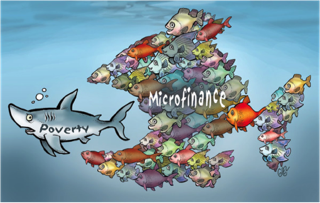
What is Micro Financing?
Microfinance – defined as the access to and usage of quality financial services, including savings, credit, insurance and money transfer systems – is crucial for low-income households to manage cash flows to finance day-to-day living, manage risks, invest productively, and respond to financial shocks. The low levels of financial inclusion in the Middle East and North Africa (MENA) region, however, have left many with limited access to any sort of financial services. This is especially true for certain groups such as women and young people.
According to Findex, the region has the lowest percentages of adults with a formal bank account (18%) and of poor people with formal access to financial services (9%). Only 13 percent of women have an account at a formal financial institution (versus 23% of men). Only two percent of young adults (aged 15-24) had savings in a formal financial institution in 2011, compared to 9.4 percent in Sub-Saharan Africa
As the World Bank MENA financial sector flagship report points out, the microfinance sector in the region is still small. Microcredit accounts for just 0.2 percent of the region’s Gross Domestic Product. Lending by microfinance providers reaches only 1.8 percent of the adult population, half the rate of South Asia or Latin America and the Caribbean. Even in Morocco, the country that has made most progress in developing the industry, microcredit loans barely exceed one percent of total bank credit as compared with seven percent in Latin America and the Caribbean and five percent in Africa.
While each country in the region poses unique challenges, low levels of microfinance penetration in MENA can be attributed to a lack of regulation that supports robust growth of microfinance institutions (MFIs). The inability of MFIs to accept deposits in many of the region’s markets, underdeveloped financial infrastructure, and low levels of financial literacy among potential beneficiaries all contribute to the limited microfinance outreach in the region.
The level of financial exclusion in MENA is particularly worrying given demographic and economic participation trends. As the recent MENA gender report revealed, three out of four working-age women do not participate in the labor force and constitute 80 to 90 percent of MENA’s inactive population.
While impact assessments and cases of client over-indebtedness have led to some well warranted reflections on its benefits, microfinance remains relevant for female economic empowerment. It creates opportunities for business expansion and productive investment at the household level by circumventing many of the socio-economic barriers that prevent women from participating in the economy. Similarly, microfinance can address financing gaps and help promote a culture of innovation and entrepreneurship among the region’s young people. This is particularly important given that youth unemployed in the MENA – at about 25 percent – exceeds that of any other region in the world.
A World Bank project was recently launched to tackle the obstacles standing in the way of the regional expansion of microfinance. The Enhancing Microfinance Amongst Women and Youth in MENA Project, financed under the MENA Multi-Donor Trust Fund (MDTF), will focus on three key areas:
First, it addresses a critical knowledge gap. Existing microfinance beneficiaries knew where and how to access credit. Yet this relatively small number begs the question of how many more women and young people might also want access to financial services but do not know where or how to find it. Acknowledging that there has been no comprehensive analytical work done on establishing demand-side constraints to microfinance in MENA, the project will undertake a study to gauge the extent of pent-up demand in Egypt, Morocco, and Tunisia.
The study will consist of:
- demand-side surveys of potential microfinance beneficiaries;
- in-depth interviews and focus group discussions;
- and analysis of existing household surveys to identify and uncover barriers to accessing and using the formal financial system for women and young people. A key objective will be to gain an understanding of the financial needs of women and young people, and an understanding of the factors (e.g. geographic, gender, economic) that constrain their access and usage of financial services. The work will build on recent demand-side research initiatives such as financial diaries and finscope surveys.
Second, as enough evidence exists to indicate that financial literacy is a key impediment to accessing financial services, the project will develop and implement a financial education tool kit targeted to low-income, ‘unbanked’ women and young people in Egypt, Morocco, and Tunisia. The tool kit will be developed for use by MFIs, financial service providers, and related Non-Governmental Organizations in these same three countries. The project will also train trainers so that the momentum toward expanded increased financial literacy becomes self-sustaining.
Finally, significant resources will be dedicated to enhancing the capacity of MFIs to effectively serve women and young people through targeted learning exchanges between MFIs in Egypt, Morocco, and Tunisia, and leading MFIs in MENA. The learning exchanges will focus on the operational and strategic investments needed to better serve women and young people with financial services.
Source:
http://blogs.worldbank.org/user/9380
An article by Peter McConaghy of the World Bank


 See all micro-credit institutions in the Arab World
See all micro-credit institutions in the Arab World


Copyright © 2024 The Olive Tree SAL, all rights reserved. Terms of Use | Privacy Policy